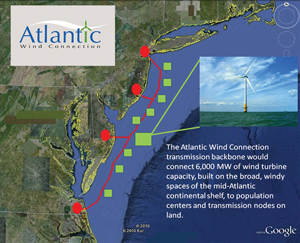Internet giant Google, along with fellow sponsors Good Energies and Marubeni Corporation, and independent transmission company Trans-Elect, announced a transmission megaproject on October 12.

The Atlantic Wind Connection (AWC) is designed to accelerate offshore wind development by providing a transmission backbone for a host of potential offshore wind projects, each of which would otherwise face the hurdle of having to connect to a more distant on-land transmission line. Conceptually it’s similar to Ontario’s plan for enabler lines that can be put in place to enable a cluster of new generation to be built with assurance of timely transmission connection.
The Mid-Atlantic region offers more than 60,000 MW of offshore wind potential in the relatively shallow waters of the outer continental shelf. These shallow waters, which extend miles out to sea, allow for the development of large, distant wind farms, mitigating visibility issues and allowing for greater energy capture from stronger winds. With few other renewable energy options ideally suited for the Atlantic coast, this transmission project will help states meet their renewable energy goals and standards by enabling the local offshore wind industry to deploy thousands of megawatts of clean energy.
Without a transmission backbone, offshore wind developers would be forced to bring energy to land via radial lines that can make balancing the region’s existing grid more difficult. In addition, a single offshore backbone with a limited number of landfall points will minimize the environmental impacts of building multiple individual radial lines to shore. The AWC project not only reduces the need to build many lower-capacity transmission lines, but relieves grid congestion in one of two National Interest Electric Transmission Corridors that were deemed to have significant transmission network congestion and need speedy creation of transmission capacity.
When complete, the AWC backbone will be able to connect 6,000 MW of offshore wind, enough power to serve approximately 1.9 million households. The system is also scalable and can be expanded to accommodate additional offshore wind energy as the industry further develops. The use of High Voltage Direct Current (HVDC) technology allows for easier integration and control of multiple wind farms while avoiding the electrical losses associated with more typical High Voltage Alternating Current (HVAC) lines. With this strong backbone in place, larger and more energy efficient wind farms can connect to offshore power hubs further out to sea. These power hubs will in turn be connected via sub-sea cables to the strongest, highest capacity parts of the land-based transmission system, the developers say.
“The AWC backbone will both relieve transmission congestion in one of the nation’s most restricted power markets as well as enable the development of a huge offshore wind capacity that can bring stability and security to the Eastern Power Grid,” said John Breckenridge, Managing Director at Good Energies. “With this line in place, offshore projects can be constructed at lower cost, with less impact on the environment and with the ability to deliver power wherever it is needed along the Mid-Atlantic coast.”
